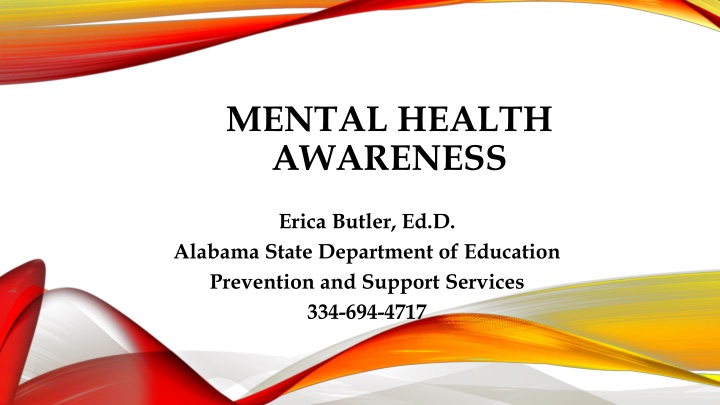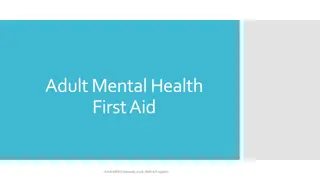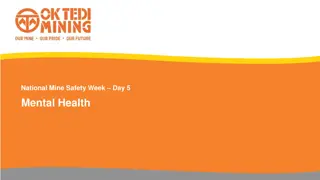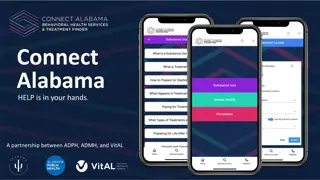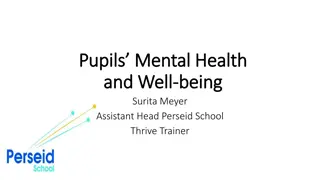Youth Mental Health in Alabama: Statistics & Support Services
This collection of images and statistics sheds light on the mental health landscape among the youth in Alabama. It highlights the prevalence of mental illness, rates of access to care, and the impact of depression and substance use disorders on high school students. The distinction between mental illness and mental distress is explained, along with the causes of mental illness during childhood and adolescence. The importance of a state of well-being for individuals' overall success and contribution to their communities is emphasized.
Download Presentation

Please find below an Image/Link to download the presentation.
The content on the website is provided AS IS for your information and personal use only. It may not be sold, licensed, or shared on other websites without obtaining consent from the author.If you encounter any issues during the download, it is possible that the publisher has removed the file from their server.
You are allowed to download the files provided on this website for personal or commercial use, subject to the condition that they are used lawfully. All files are the property of their respective owners.
The content on the website is provided AS IS for your information and personal use only. It may not be sold, licensed, or shared on other websites without obtaining consent from the author.
E N D
Presentation Transcript
MENTAL HEALTH AWARENESS Erica Butler, Ed.D. Alabama State Department of Education Prevention and Support Services 334-694-4717
2022 MENTAL HEALTH STATISTICS AL Youth ranks 20 out of 51 states for prevalence of mental illness and rates of access to care. 54,000 (14.51%) AL youth report at least one major depressive episode (MDE) in the past year. 27,000 (7.5%) AL youth experienced severe major depressive episode 44,000 AL youth ages 12-17 suffer from depression 34,000 (66.8%) AL youth did not receive any care in the last year. 8,000 (31.3%) received some consistent treatment 1420 (2.13%) AL students identified with emotional disturbance on their IEP
2022 MENTAL HEALTH STATISTICS AL High school students with depression are more than 2x more likely to drop out than their peers. Depression often co-occurs with substance use disorders, anxiety and disorderly behavior 12,000 (3.19%) AL Youth with substance use disorder in the past year 16,000 (12.5%) Children with private insurance that did not cover mental or emotional problems 7 in 10 AL youth in the juvenile system have a mental health condition. Limited demographic data available for pediatric / adolescent cases and from private providers Data collected from Mental Health America
MENTAL ILLNESS VS. MENTAL DISTRESS Mental Illness (MI) a specific set of medically defined conditions that affect mood, thinking and behavior. Ex. - Bipolar or Schizophrenia Mental Distress - a range of symptoms and experiences of a person s internal life that are said to be troubling, confusing or out of the ordinary such as anxiety, confused emotions, hallucination, rage, and depression. Ex. - Life situations such as bereavement, stress, lack of sleep, use of drugs/alcohol, assault, abuse or accident can cause mental distress.
CAUSES OF MI DURING CHILDHOOD AND ADOLESCENCE * Drugs * Childhood Illnesses * Genetics * Traumatic Head Injury * Adverse reaction to medication * Abuse (Mental or Physical) * Sexual Assault
A state of well-being in which the individual realizes his or her own abilities, can cope with the normal stresses of life, can work productively and fruitfully, and is able to make a contribution to his or her community.
HOW CAN MENTAL HEALTH CHALLENGES INTERFERE WITH THE LEARNING PROCESS FOR STUDENTS? Difficulty processing new information Unable to objectively analyze data Unable to concentrate Forgetful
WARNING SIGNS & SYMPTOMS https://youtu.be/zt4sOjWwV3M
WHAT TO LOOK FOR? Academic Red flags Dropping grades Missed or incomplete assignments Inability or unwillingness to participate in class Writing about violence, death, suicide or other disturbing subject matter
BEHAVIORAL RED FLAGS Withdrawing or isolating Pattern of unexplained tardiness / absences Pattern of unexplained tardiness / absences Behaviors that disrupt the class Avoidance of situations that might be stressful or trigger anxiety such as participating in group assignments Seeking excessive reassurance Time management problems
PHYSICAL RED FLAGS Unexplained aches, pains, cuts, bruises, scars or burns Noticeable weight loss or gain Falling asleep in class Significant changes in appearance Signs of alcohol or drug use (breath odor, dilated pupils, etc.)
HOW DO YOUNG PEOPLE COPE WITH, MANAGE OR AVOID THEIR SYMPTOMS? Social withdrawal and isolation Substance abuse Eating disorders Self-harm cutting or hair pulling Participating in or becoming the target of bullying Excessive or compulsive reliance on sleeping, eating or screen time (TV, gaming, social media, etc.)
HOW CAN I HELP A STUDENT IN MENTAL DISTRESS? 1. Talk to the student. Name the things that you have noticed You seem ____(down, distant, angry, upset) I m sensing that you re feeling overwhelmed by today s class discussion. Talk to me and we ll figure it out together. Ask in a direct way Sometimes when people are feeling stressed like you are they have depression, anxiety and thoughts of suicide. Do you?
HOW CAN I HELP A STUDENT IN MENTAL DISTRESS? 2. Listen and show you care With a calm voice say ---- You re dealing with a lot. Talk to me, I m listening. Will you walk with me to the counselor s office?
HOW CAN I HELP A STUDENT IN MENTAL DISTRESS? 3. PRACTICE YOUR CONVERSATIONAL SKILLS Communicate respect for the student. Express empathy through reflective listening ex. I m sick and tired of people always telling me what to do and your response You don t like people ordering you around Help students see the difference between where they are and where they want to be. Affirm the positive attempts the student has made so far Summarize
4. BUILD MOTIVATION Use open-ended questions ex. Tell me why you were late to class today? Affirm and compliment Summarize and present feedback throughout the conversation Handle resistance learn the signs and practice reflective listening instead of putting up resistance of your own. Reframe his/her statements into more direct ones ex. Student says I don t know why I keep doing this and your response You are aware of the dangers and keep looking for ways to stop. Ask permission instead of offering advice as the expert, ask if it would be okay to share some other ideas.
5. STRENGTHEN THE COMMITMENT TO CHANGE Discuss a plan elicit suggestions from the student for the plan Communicate his/her free choice Provide information Deal with resistance without fighting it Develop a change plan worksheet Review, clarify, and identify gaps and answer questions Ask for commitment Ask how likely it is that the student will follow through with the plan
HOW CAN YOU HELP? THESE COMMUNICATION SKILLS TAKE TIME TO PRACTICE AND MASTER. Your central role is to teach, not diagnose or treat mental illness.
REFERENCES National Institute of Mental Health (NIMH) National Alliance on Mental Illness (NAMI) Classroom Mental Health Federal Department of Mental Health
